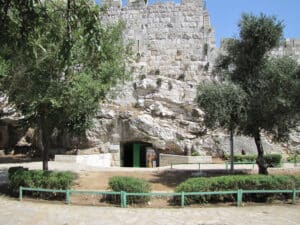Curious visitors to the Old City of Jerusalem will find an unadorned opening in the northern wall about 500 feet east of the Damascus Gate. The low entry leads to a massive series of caverns, approximately 330 feet wide and 650 feet deep. You have entered what is often called Solomon’s Quarries.
What is this place?
As you move gingerly from the northwest towards the southeast, avoiding large holes where stone has been removed, you are making your way towards the Temple Mount, about 30 feet under the surface of the Moslem Quarter. In fact, you are traversing the massive limestone base of Mount Moriah.
A careful observer will notice two or three different kinds of limestone here. Most is white limestone, locally known as malaky (melech), or “royal stone.” Less common is the the harder and beautiful mizzi-ahmar or red limestone, due to its iron content. A third, called “sweet stone,” is too soft to mine for large blocks, although limestone does harden when exposed to sun and weather.
Breaking stones loose
Along the quarry walls can be seen shallow indentations where the workmen placed their oil lamps, the black soot staining the rock to this day. And the method of removing the stones is obvious. Channels were cut to mark off the size of the rough-cut stone. Then wooden wedges were cut to fit in the channel. When the wood was soaked, it expanded and cracked the rock quite evenly due to the very regular grain.
In places, large stones can be seen, already shaped for the temple that was being build above. They have evidently been influenced by the workman’s hammer and chisel. But one day as the stone masons toiled, suddenly the call came from the foreman above, “The building is all finished. It’s time to come home.” And picking up his tools and lamp, the mason left the stone where it lay in the darkness, still attached to the bedrock.
Could it be that there are those today, influenced by the hammer of God’s Word (Jer. 23:29), who look like the stones in the living temple (Eph. 2:21), but are still attached to the bedrock of this world? What a tragedy to be left in the darkness when the project is completed without them. Today is the day of salvation.
Preparing the ashlars
Aslars are the finished or dressed stones used in building. Normally rough-cut stones are brought to the building site, then finished to fit there. But that was not the case with Solomon’s temple:
The temple, when it was being built, was built with stone finished at the quarry, so that no hammer or chisel or any iron tool was heard in the temple while it was being built (1 Ki. 6:7).
So it was that, deep under the city, unheard and unnoticed by the the inhabitants occupied with their busy lives, the work of God carried on. Each stone was shaped and prepared for its unique place in the habitation of God. And then noiselessly each was added. It’s that way with the Church today, as well.
Deep in unfathomable mines
Of never failing skill
God treasures up His bright designs
And works His sovereign will.
—William Cowper
The evening news gives no report on the number saved today. The morning paper never tells us of the progress being made as “the whole building, being joined together, grows into a holy temple in the Lord, in whom you also are being built together for a dwelling place of God in the Spirit” (Eph. 2:21-22). Silently, the building rises. May we yield to the shaping of His Word in our lives as He prepares His precious stones to be reflectors of His own glory. And may we also see in God’s people now the polished perfection that by grace will be their eternal joy. —JBN
